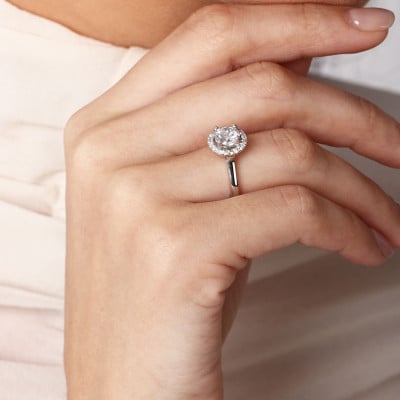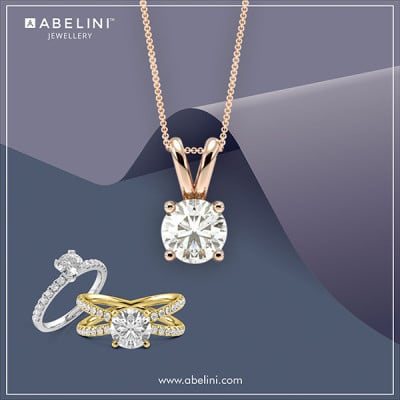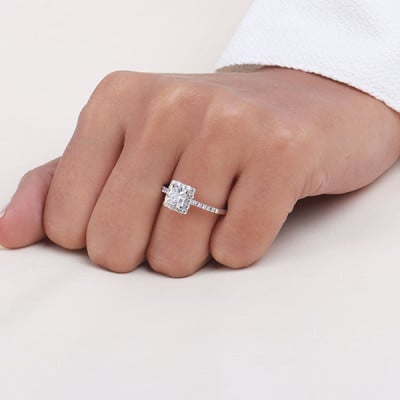Marquise Rings Buying Guide
If you're buying an engagement or wedding ring, you may be after a classic diamond cut, or you may be buying for someone who'd enjoy something a little more unusual. If the latter applies, a marquise ring may be a perfect choice.
At Abelini, you'll find a great selection of marquise engagement rings and wedding rings. Here is everything you need to know about what a marquise ring is, what to look for in a marquise diamond, and how popular they are.
What Does Marquise Mean In Rings?
With its elongated shape - which resembles an eye or a little boat - the marquise cut diamond is a beautiful elliptical gem that has a romantic history. Its shape dates back to the 1740s and was inspired by the lips of the Marquise de Pompadour: King Louis XV's mistress.
Because of their shape and size - and the number of facets their stones contains - these are rings that are designed to stand out. The stone is often set vertically, which can help to elongate the look of the fingers but can also be set horizontally, depending on personal preference.
During King Louis XV's times, this cut was often worn by courtiers to symbolise their rank. Aside from its noble connotations, the marquise cut's similarity to other objects can make it perfect for a variety of interests. Its shape has been compared with an American football, a lemon, a boat, and even a cat's eye, meaning you can add your own symbolism if its shape has special significance to you.
How To Choose The Best Marquise-Cut Diamond?
It's important to know what to look for in a marquise diamond. There are four main things you should consider when buying a marquise ring:
1. Length To Width Ratio: This is calculated by dividing the length of your diamond by its width. The ratio you choose will be driven by your own personal preference, but ratios between 1.70 and 2.15 tend to be the most popular for this cut.
2. Clarity: Check to see if there are any visible inclusions in the diamond. Don't just go by grade: the most important thing is to ensure that any inclusions aren't visible to the naked eye. However, be sure to check the pointed ends of a marquise diamond, as inclusions here can compromise its integrity if not properly protected when set.
3. Symmetry: Any issues with a marquise diamond's symmetry - no matter how small - can affect the balance of the diamond. Unlike other diamond shapes, the marquise cut is unforgiving: the slightest flaw in symmetry will be easier to spot. Check the curve of the wings, as well as the symmetry of the facets, the length and the width of the stone.
4. Colour: Marquise diamonds will often show colour more than other diamond shapes - and this colour will be more evident towards the tips. The colour you choose will often depend on the metal you are pairing the diamond with. H or better will work best with platinum or white gold, while anything down to K will allow your diamond to maintain a colourless look in a yellow or rose gold setting thanks to reflection.
Are Marquise Rings In Style In 2025?
Marquise rings were particularly popular in the 1980s - and like many things from this era, they're still a popular choice today. Some prefer a more traditional setting, while others opt for a more contemporary marquise style.
Marquise cut diamonds have proven popular with a number of celebrities, with the likes of Victoria Beckham, Catherine Zeta-Jones, Jennifer Lopez and Ashlee Simpson all having sported this beautiful style.
Faq
There are three different tests you can do to check if a marquise diamond is real:
1. The Fog Test: Breathe onto the diamond, as if you are breathing on the lenses of a pair of glasses to clean them. With a real diamond, the fog from your breath will clear immediately. It will take a good few seconds with a fake diamond.
2. The Water Test: Here, you will need the loose stone. Put it into a full glass of water. A real diamond should sink to the bottom of the glass, while a fake will float either on the surface or just below.
3. The Read-Through Test: Again, you will need the loose stone. Place it on top of some printed text, such as a book or magazine. If you can read through the gem, it is likely to be fake: a diamond (especially a marquise, with its many facets) will refract light so strongly that the text cannot be read.
The cut of a marquise diamond is incredibly elaborate - and as a result, it will typically have 58 facets. Because of their cut and their multifaceted nature, marquise diamonds often look larger (and sometimes more sparkly) than regular diamonds of the same carat weight, making them ideal for those who prefer larger gems.
Aside from its uniqueness (it is one of the less common cuts chosen for wedding and engagement rings), there are other reasons why people opt for a marquise cut ring. Not only does it flatter shorter fingers, but it also has a larger surface area than other diamonds, making it look bigger. Marquise diamonds are often also priced lower than round diamonds, and their cut is more forgiving to minor flaws.
However, there are some downsides. The quality of the cut can sometimes lead to a dark "bow tie" effect in the centre, which can detract from its beauty. The pointed tips are also more prone to yellow tints - and these tips should also be protected by V-shaped prongs. Without these, they can be prone to chipping.
If you have any further questions about buying marquise rings, get in touch and we'll be happy to help.

Article written by Nilesh
 Trustpilot
Trustpilot



